Thirumalisai Alvar
This article is about Saint Thirumalisai Alvar. For the Tamil language film, see Thirumalisai Alvar (1948 film)
| Thirumalisai Alvar | |
|---|---|
| Born | Thirumazhisai |
| Titles/honours | Alvar saint |
| Philosophy | Vaishnava Bhakti |
Thirumalisai Alvar is a Tamil saint revered in the Srivaishnavism school of south India, in Tondai Nadu (now part of Kanchipuram and Tiruvallur districts). He was born in 4203 BCE.[1][2] The legend of this saint devotees of Srivaishnavism believe that he was the incarnation of Vishnu's disc, Sudarshana. He is believed to have been born at Jagannatha Perumal temple, Tirumazhisai by divine grace.
A childless tribal couple called Tiruvaalan and Pankaya Chelvi engaged in cutting canes found the child and took it home. The couple also had a son named Kanikannan who was a disciple of Thirumalisai Alvar.
Thirumalisai Alvar proclaimed that he didn't belonged to Brahmin, Kshatriya, Vaishya & Shudra in one of his couplets as he was considered (Avarna) untouchable and casteless person.
Azhwars
The word azhwar means the one who dives deep into the ocean of the countless attributes of god. Azhwars are considered the twelve supreme devotees of Vishnu, who were instrumental in popularising Vaishnavism. The religious works of these saints in Tamil, songs of love and devotion, are compiled as Nalayira Divya Prabandham containing 4000 verses and the 108 temples revered in their songs are classified as Divya desam.[3][4] The saints had different origins and belonged to different castes. As per tradition, the first three azhwars, Poigai, Bhutha and Pey were born miraculously. Tirumizhisai was the son of a sage, Thondaradi, Mathurakavi, Peria and Andal were from brahmin community, Kulasekhara from Kshatria community, Namm was from a cultivator family, Tirupana from panar community and Tirumangai from kazhwar community. Divya Suri Saritra by Garuda-Vahana Pandita (11th century AD), Guruparamparaprabavam by Pinbaragiya Perumal Jiyar, Periya tiru mudi adaivu by Anbillai Kandadiappan, Yatindra Pranava Prabavam by Pillai Lokacharya, commentaries on Divya Prabandam, Guru Parampara (lineage of Gurus) texts, temple records and inscriptions give a detailed account of the azhwars and their works. According to these texts, the saints were considered incarnations of some form of Vishnu. Poigai is considered an incarnation of Panchajanya (Krishna's conch), Bhoothath of Kaumodakee (Vishnu's Mace/Club), Pey of Nandaka (Vishnu's sword), Thirumalisai of Sudarshanam (Vishnu's discus), Namm of Vishvaksena (Vishnu's commander), Madhurakavi of Vainatheya (Vishnu's eagle, Garuda), Kulasekhara of Kaustubha (Vishnu's necklace), Periy of Garuda (Vishnu's eagle), Andal of Bhoodevi (Vishnu's wife, Lakshmi, in her form as Bhudevi), Thondaradippodi of Vanamaalai (Vishnu's garland), Thiruppaan of Srivatsa (An auspicious mark on Vishnu's chest) and Thirumangai of Saranga (Rama's bow). The songs of Prabandam are regularly sung in all the Vishnu temples of South India daily and also during festivals.[4][5]
Early life
The name of the Azhwar comes from his birthplace, Thirumazhisai, a suburb in modern day Chennai.[6] He was born to Bhargava maharishi and his wife Kanakangi after an unusual 12 months stay in the womb. The fetus came out as just a lifeless lump of flesh with no arms and legs. The couple were terribly depressed and with unwillingness left it under a bamboo bush and proceeded with their spiritual journey. Vishnu appeared with his consort and blessed the "flesh" with their kataksham and it turned into an lively human being.
He was later picked up with both the arms affectionately by a tribal named Thiruvalan. A really blessed couple Thiruvalan and pankajavalli, was overwhelmed by the grace of god for this gift of a baby. The boy grew on to become Thirumazhisai azhwar. He also has an eye on his right leg.He lived up to 10 years of age in a hamlet near thirumazhisai village named as Pirayampathu. This Alwar was an incarnation of Sudarsana Chakra ( the divine discus of Lord Vishnu).
Thirumazhisai Alwar decided to learn about all other religions. He studied Buddhist, Jain and other literature. He became a staunch devotee of Siva assuming the name of Siva Vakya. One day, he saw an old man planting a plant upside down and then trying to water it with a broken pot using a tattered rope to lift water from a waterless well. Sivavakyar asked him why he was attempting such a foolish act. The old man was none other than Pey Alwar who replied that what he was doing was only less foolish than Sivavakya's allegiance to Saivism, knowing full well that the Vedas and Smritis proclaim Sri Narayana as the Supreme deity.As a result of an argument with Pey Alwar, finally he got initiated into Vaishnavism by Pey Alwar.
It is said that Lord Shiva gave him his darshan and offered him a boon that the alwar would seek. The Alwar wanted 'Moksha" for which Lord Shiva replied that he wil not do that since Alwar was an incarnation of Sudarsana Chakra, and the next is the Alwar wanted a Long Life for which Lord Shiva replied that it has already been pre-ordained. The great Alwar then asked Lord Shiva that if he could not grant 'Moksha' and only Lord Narayana could then he could offer his services to Narayana only. Lord Shiva then granted him the title 'Bakthisara" the honorofic by which he came to be known. After visiting several temples, he reached Tiruvekka, the birthplace of Poigai Alwar.
Learning different religions
Thirumazhisai decided to learn about all other religions. So, he studied Buddhism, Jainism and other literature. He became a staunch devotee of Siva assuming the name of Siva VAkya. One day, he saw an old man planting a plant upside down and then trying to water it with a broken pot using a tattered rope to lift water from a waterless well. Sivavakyar asked him why he was attempting such a foolish act. The old man was none other than Pey AzhwAr who replied that what he was doing was only less foolish than Sivavakya's allegiance to Saivam, knowing full well that the Vedas and Smritis proclaim Sri Narayana as the Supreme deity.
As a result of an argument with Pey Azhwar, he finally got initiated into Srivaishnavam by Peyalvar. After visiting several temples, he reached Tiruvekkaa, the birthplace of Poigai Alwar. Tirumazhisai Azhwar himself says
Tamil
சக்கியம் கற்றோம், சமணம் கற்றோம், சங்கரனார் ஆக்கிய ஆகமநூல்
ஆராய்ந்தோம்; பாக்கியத்தால் வெங்கட்கரியனை சேர்ந்தோம்Transliteration
sAkkiyam katrOm, SamaNam katrOm, SankaranAr aakkiya Aagamanool
aarAindhOM; BhaggiyathAl venkaTkariyAnai SerndOm
“ We had learned SAkkiyam (Buddhism) SamaNam (Jainism) and the Agamic Scriptures made by Lord Shankara (Shiva); Due to sheer grace, we landed at the feet of TiruvengadathAN. ”
There is also evidence in his couplets that show that he asked God to help reveal their ignorance to them.
Displeasing Pallava king
Legend also says that when Kanikannan, his disciple displeased the pallava king for not agreeing to restore the king's youth. Earlier on he granted youth to an old unmarried maid of the temple. The king married that woman but he himself was an old man and thus wanted to enjoy life as a youth with his new wife. Tirumalisai refused him and the king decided to banish him. Tirumalisai Alvar asked the God from the temple, Yathotkari, to leave with him.
Tamil
கணிகண்ணன் போகின்றான் காமரு பூங் கச்சி
மணிவண்ணா! நீ கிடக்க வேண்டா
செந்நாப் புலவனும் போகின்றேன் நீயும் உன்றன்
பை நாகப்பாயை சுருட்டிக் கொள்Transliteration
KanikaNNan Poginraan Kaamaru poong Kachi
ManivaNNaa! Nee Kidakka Vendaa
Sennaap Pulavanum Poginren Neeyum Unran
Pai Naagappaayai Suruttik KoLL
“ KanikaNNan is going out of kAnchi Oh! Manivanna!, You don't have to lie here anymore. Since, as the fluent poet that I am also leaving with him, you also roll your serpent bed and follow me"And, accordingly all of them left KAnchipuram ”
Vishnu is said to have rolled up the snake Sesha like a mattress and left with him.
Mangalasasanam
There are 216 of his paasurams in the 4000 Divya Prabhandham. His first Prabandham named Thiruchchanda Viruththam contains 120 hymns and starts from 752 paasuram and ends at 871 paasuram. The second Prabandham of Thirumalisai Alvar is titled Naanmugan Thiruvandhadhi and it contains 96 verses. The work of Naanmugan Thiruvandhadhi starts from 2382 paasuram and ends at 2477 paasuram.
He has sung in praise of 20 temples.[7]
| S.No. | Name of the temple | Location | Photo | Presiding deity | Notes/Beliefs |
|---|---|---|---|---|---|
| 1 | Thiru Kapistalam/ | 10°56′46″N 79°15′22″E / 10.946°N 79.256°E | |||
| 2 | Thiru Anbil.[8] | Anbil Tiruchirappalli district 10°52′N 78°53′E / 10.86°N 78.88°E |
 |
Sundararaja Perumal Azhagiya Nambi Perumal |
The temple is located on the Northern bank of the river Kollidam, at a distance of 25 km (16 mi) from Trichy. King Sundara Chola who ruled the area was a devotee of the temple and during each of his innumerable victories in wars, he showered a lot of wealth on this temple. His prime minister Anirudha Brahmarayar is believed to be from Anbil, the village where the temple is located. The copper plates having the records from the Chola period from Anbil indicate generous contribution from the Medieval Cholas indicate various gifts to the temple.[9][10] |
| 3 | Thiruevvul.[8] | 13°08′35″N 79°54′25″E / 13.143°N 79.907°E | 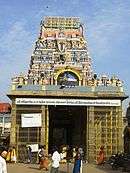 |
||
| 4 | Thiru urakam.[11] | 12°50′20″N 79°42′18″E / 12.839°N 79.705°E | 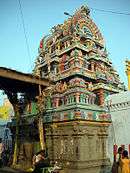 |
||
| 5 | Thiruvallikeni.[12] | 13°03′14″N 80°16′37″E / 13.053884°N 80.277020°E |  |
||
| 6 | Thirupper Nagar. | 10°50′21″N 78°53′21″E / 10.839282°N 78.889070°E | |||
| 7 | Thirukkurungudi.[13] | 8°26′10″N 77°33′57″E / 8.436096°N 77.565933°E |  |
||
| 8 | Tiruvekkaa.[14] | 12°49′26″N 79°42′43″E / 12.824°N 79.712°E |  |
||
| 9 | Tiruppatakam.[15] | 12°50′31″N 79°41′46″E / 12.842°N 79.696°E | 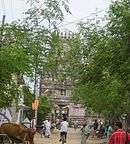 |
||
| 10 | Thirukoshtiyur.[16] | 10°03′36″N 78°33′36″E / 10.060°N 78.560°E | 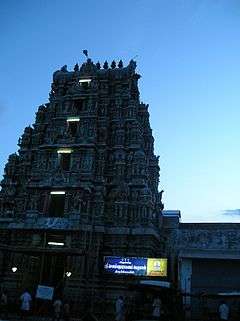 |
||
| 11 | Thirukkudandhai.[16] | 10°57′32″N 79°22′30″E / 10.959°N 79.375°E | |
||
| 12 | Thiruvenkadam . | 13°41′00″N 79°20′51″E / 13.683304°N 79.347406°E |  |
||
| 13 | Tirupparkatal. | .jpg) |
|||
| 14 | Srirangam. | Srirangam, Trichy district Tamil Nadu 10°51′45″N 78°41′23″E / 10.8625°N 78.689722°E |
 |
Ranganayagi Ranganathar (Periya Perumal) |
Srirangam temple is often listed as the largest functioning Hindu temple in the world, the still larger Angkor Wat being the largest existing temple. The temple occupies an area of 156 acres (631,000 m²) with a perimeter of 4,116m (10,710 feet) making it the largest temple in India and one of the largest religious complexes in the world.[17][18] The annual 21-day festival conducted during the Tamil month of Margazhi (December–January) attracts 1 million visitors.[19] |
| 15 | Azhagar Kovil.[13] | 10°04′26″N 78°12′47″E / 10.074°N 78.213°E | |
||
| 16 | Appakkudathaan Perumal Temple.[13] | Koviladi, Trichy district Tamil Nadu 10°52′N 78°53′E / 10.86°N 78.88°E |
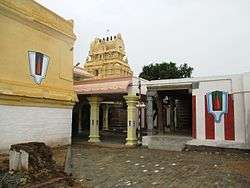 |
Indravalli Appala Ranganatha Perumal |
The temple has inscriptions from the 18th year of the reign of Aditya Chola.[20] The recorded inscriptions in this temple are numbered 283, 300, 301 and 303 of 1901.[21] The temple is one of the five Pancharanga Kshetrams (also called Pancharangams,
meaning the "five Rangams or Ranganathas"), a group of five Hindu temples on the banks of the Kaveri River dedicated to Ranganatha, a form of Vishnu.[22][23] |
Notes
- ↑ L. Annapoorna (2000). Music and temples, a ritualistic approach. p. 23. ISBN 9788175740907.
- ↑ Sakkottai Krishnaswami Aiyangar (1911). Ancient India: Collected Essays on the Literary and Political History of Southern India. pp. 403–404. ISBN 9788120618503.
- ↑ Rao, P.V.L. Narasimha (2008). Kanchipuram – Land of Legends, Saints & Temples. New Delhi: Readworthy Publications (P) Ltd. p. 27. ISBN 978-93-5018-104-1.
- 1 2 Dalal 2011, pp. 20-21
- ↑ Ramaswamy, Vijaya (2007). Historical Dictionary of the Tamils. Scarecrow Press. p. 211. ISBN 9780810864450.
- ↑ Ramakrishna Mission (1998). "Bulletin of the Ramakrishna Mission Institute of Culture". 49. The Institute: 535–538.
- ↑ Pillai, M. S. Purnalingam (1904). A Primer of Tamil Literature. Madras: Ananda Press. pp. 182–83.
- 1 2 Kodayanallur Vanamamalai 2001, p. 51
- ↑ "Sri Sundararaja Perumal temple". Dinamalar. Retrieved 2013-09-09.
- ↑ Ayyar, P. V. Jagadisa (1982). South Indian Shrines: Illustrated. New Delhi: Asian Educational Services. p. 533. ISBN 9788120601512.
- ↑ Kodayanallur Vanamamalai 2001, p. 52
- ↑ T. 2002, p. 85
- 1 2 3 Kodayanallur Vanamamalai 2001, p. 59
- ↑ Kodayanallur Vanamamalai 2001, p. 70
- ↑ T. 2002, p. 86
- 1 2 Kodayanallur Vanamamalai 2001, p. 58
- ↑ Mittal, Sushil; Thursby, G.R. (2005). The Hindu World. New York: Routelge. p. 456. ISBN 0-203-67414-6.
- ↑ Vater, Tom (2010). Moon Spotlight Angkor Wat. USA: Perseus Books Group. p. 40. ISBN 9781598805611.
- ↑ Jones, Victoria (2004). Wonders of the World Dot-to-Dot. New York: Sterling Publishing Co., Inc. p. 4. ISBN 1-4027-1028-3.
- ↑ Jouveau-Dubreuil, Tony (1994). The Pallavas. New Delhi: Asian Educational Services. p. 77. ISBN 81-206-0574-8.
- ↑ Jouveau-Dubreuil, G. (1994). Pallava Antiquities – 2 Vols. Asian Educational Services. p. 13. ISBN 978-81-206-0571-8.
- ↑ S., Prabhu (16 September 2010). "Restoring the glory of a temple". The Hindu. Retrieved 2013-09-09.
- ↑ Soundara Rajan, Kodayanallur Vanamamalai (2001). Concise classified dictionary of Hinduism. New Delhi: Concept Publishing Company. p. 65. ISBN 81-7022-857-3.
References
- B. S., Chandrababu; S., Ganeshram; C., Bhavani (2011). History of People and Their Environs. Bharathi Puthakalayam. ISBN 9789380325910.
- Chari, S. M. Srinivasa (1997). Philosophy and Theistic Mysticism of the Āl̲vārs. Motilal Banarsidass Publishers. ISBN 9788120813427.
- Dalal, Roshen (2011). Hinduism: An Alphabetical Guide. Penguin Books India. ISBN 9780143414216.
- Kodayanallur Vanamamalai, Soundara Rajan (2001). Concise classified dictionary of Hinduism. New Delhi: Concept Publishing Company. ISBN 81-7022-857-3.
- T., Padmaja (2002). Temples of Kr̥ṣṇa in South India: history, art, and traditions in Tamilnāḍu. New Delhi: Shakti Malik. ISBN 81-7017-398-1.